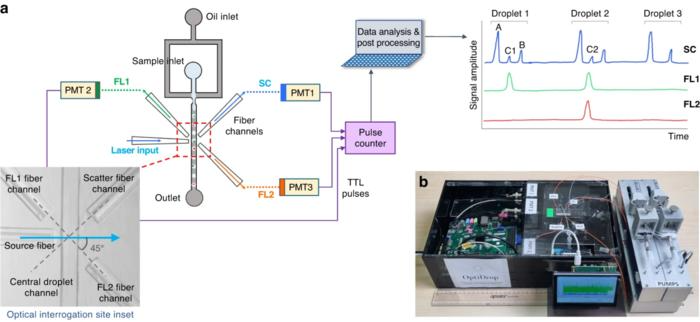Reviewed by Lexie CornerApr 2 2024
The OptiDrop platform, which integrates novel optical fibers into microfluidic chips to revolutionize droplet microfluidics, is presented in a recent study. With the increased sensitivity for detecting fluorescence and scatter signals, this innovation provides quick and affordable insights into proteins, metabolites, and genetics.
 Device setup. Image Credit: Microsystems & Nanoengineering
Device setup. Image Credit: Microsystems & Nanoengineering
Droplet microfluidics transforms single-cell analysis, crucial for genomics, drug discovery, and diagnostics, by splitting samples into nanoliter droplets for in-depth cellular analysis. However, the intricate and expensive techniques needed to examine the optical characteristics of droplets impede its wider implementation. This restriction highlights how urgently simpler and more affordable optical sensing technologies are required to realize the full potential of droplet microfluidics in various applications.
Recent research revealed a novel technique that uses on-chip fiber optics within droplet microfluidic applications to enable multiplexed fluorescence and scatter detection with previously unheard-of single-cell resolution.
The OptiDrop platform’s cutting-edge technology represents a substantial shift from conventional single-cell analysis techniques. OptiDrop allows light scatter and fluorescence from droplets to be detected on-chip by directly integrating advanced optical fiber technology into microfluidic chips. With this innovative method, it is possible to analyze cellular components with unprecedented precision and detail, avoiding the need for expensive and time-consuming high-speed imaging techniques and sophisticated traditional microscopy.
The platform’s ability to perform differential expression analysis of cell surface biomarkers, such as major histocompatibility complex proteins, has been proven by extensive testing. This demonstrates OptiDrop’s ability to perform scalable, high-throughput analysis and its potential for identifying minute biological variations.
The OptiDrop platform marries the flexibility of flow cytometry with droplet microfluidics' power, offering scalable optical sensing solutions that were previously unimaginable in research and diagnostics.
Preksha Gupta, Project Lead Researcher, Discovery Innovation Accelerator, Center for Cellular and Molecular Platforms
The potential of fusing cutting-edge optical sensing techniques with microfluidic technologies is demonstrated by the OptiDrop platform. With its adaptable, scalable, and reasonably priced single-cell analysis solution, OptiDrop opens the door for revolutionary developments in biomedical research and diagnostics.
Journal Reference:
Gupta, P., et al. (2024) Multiplexed fluorescence and scatter detection with single cell resolution using on-chip fiber optics for droplet microfluidic applications. Microsystems & Nanoengineering. doi.org/10.1038/s41378-024-00665-w